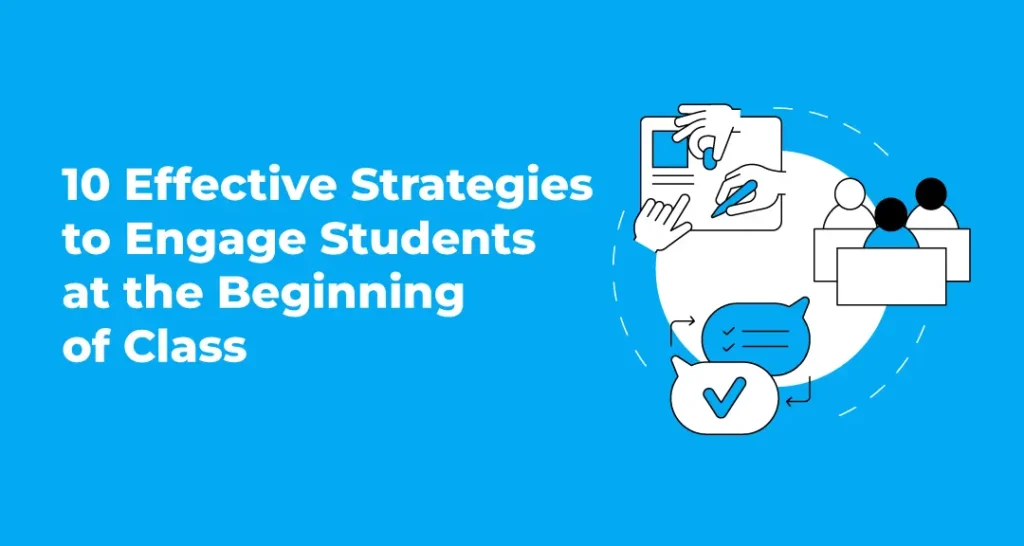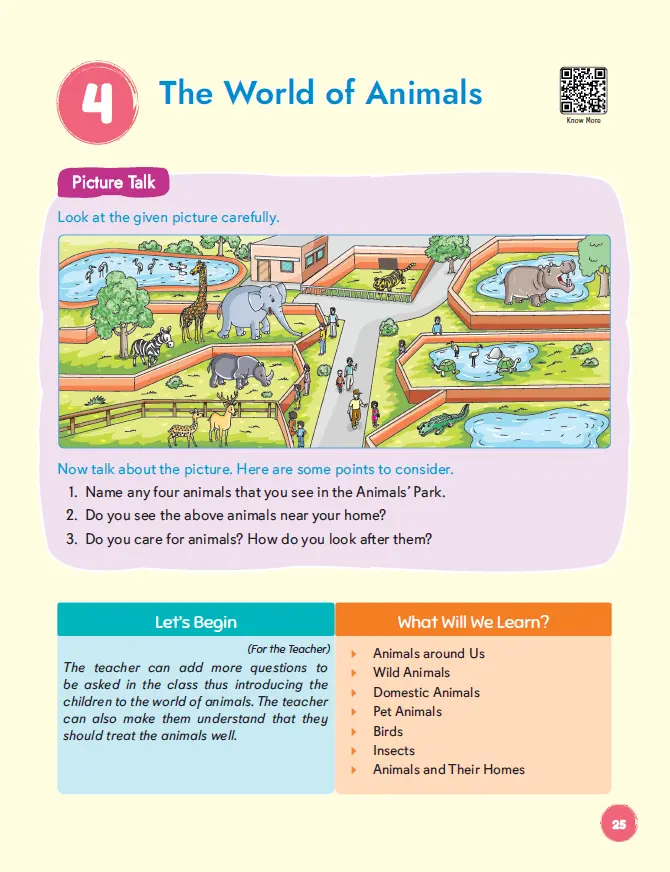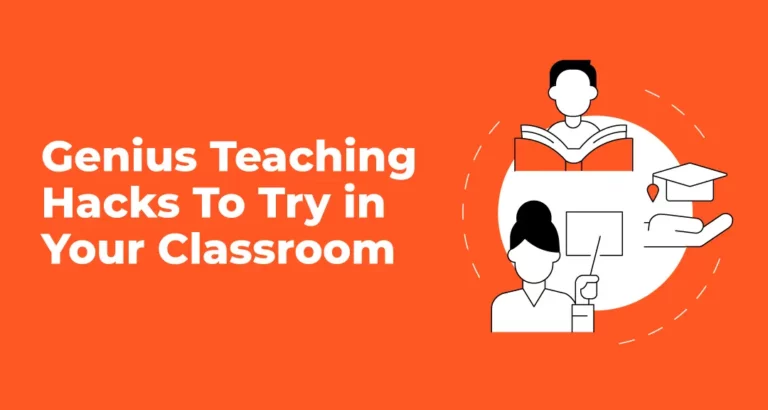10 Effective Strategies to Engage Students at the Beginning of Class
- School Leaders, Teaching
- March 22, 2025
- VOLT Learning

“Eyes up here! Stay focused! Can I have your attention, please?” Sound familiar? Every teacher has had that moment in the classroom when she tries every trick possible to get young minds to settle down and concentrate. Students’ brains are generally preoccupied with many active thoughts and distractions when they walk inside the classroom. With too short attention spans, keeping their distracted minds engaged for a 30-minute classroom session daily is nothing short of an uphill task for a teacher.
Do you know students’ attention spans may vary by age? Here’s the proof:
- Elementary school students: 5–7 minutes
- Middle school students: 7–10 minutes
- High school students: 10–15 minutes
To turn an ordinary learning session into a captivating classroom, a teacher needs to embrace the 4Cs of effective learning strategies, i.e., collaboration, communication, creation, and critical thinking, that create a positive learning atmosphere. As Jennifer Stanchfield discovered, “more is learned through exploring and struggling than by being provided the answer.” When kids are exposed to interesting and creative ways of learning, they develop more curiosity, which keeps them engaged for a longer period.
But the most important question is: How to engage students in class? Here are ten effective student engagement activities to motivate them as active learners.
10 Effective Teaching Strategies & Activities to Engage Students During the Lessons

1. Begin with an interesting question
A thought-provoking question is key to sparking instant curiosity among kids and retaining their interest as an active learner. As an educator, you can start the classroom with an interesting open-ended question to set the tone for the lesson. It can be a fun riddle, a logical brain teaser, a playful message on the board or a “what would you do?” scenario. Such questions are game-changers in starting the conversations and help students develop critical thinking while setting the stage for an engaging yet fruitful discussion. You can take the help of the VOLT Learning books, which, at the beginning of each chapter, help the students find fun-based activities coupled with captivating stories that introduce topics in a stimulating way.

Image Courtesy: VOLT Science Class 1, chapter 4
2. Use a short and engaging video
The power of visuals over text is undeniable when communicating a message. The human brain operates images at a speed 60,000 times faster than text-based instructions because it requires merely 13 milliseconds to decode a visual stimulus, while visual signals make up 90% of all brain neural activity. No wonder animated short videos are a powerful tool in the educational ecosystem for capturing students’ attention and making complex concepts easy to understand.
Research suggests that students retain 95% of information when they watch a video, compared to just 10% when reading text (Forrester Research). When students engage with a dynamic combination of visuals, storytelling, and audio, they absorb learning in a memorable way.
Teachers can also use animated videos to introduce new topics, explain abstract concepts, or summarize key takeaways engagingly. For example, a two-minute animated clip on the water cycle can visually demonstrate evaporation, condensation, and precipitation far more effectively than a textbook diagram. VOLT Learning’s digital resources offer high-quality educational videos that align with curriculum topics, making it easier for teachers to increase student participation through a thoughtful integration of multimedia content seamlessly.
3. Start with a quick mindful meditation session
We all know the calming and soothing benefits of mindfulness meditation. When kids are engaged in a guided 5-minute meditation session before the classroom learning session, they escape from disruptive thoughts, and their calm minds can focus, regulate negative emotions, and manage distractions efficiently.
As an educator, you can implement simple mindfulness exercises, such as deep breathing and breathing out coupled with closing their eyes, to help them settle in and refocus their attention. By making meditation a regular part of the classroom, you create a calm and focused learning environment and prepare their minds to absorb knowledge.
4. Introduce a ‘mystery object’
Curiosity has a more significant role in driving creative learning among kids. Show a mystery item or display a picture of a lesson-specific topic so students can determine its relevance. For example – when teaching a history chapter, you can show an aged photograph and then ask students to explain their observations from the image. When similar kinds of effective study techniques are introduced inside the classroom, they develop a connection with the specific topic you (as an educator) plan to introduce before diving into the details.
5. Incorporate a quick memory game
Brain-teasing memory games are excellent classroom engagement strategies for kids’ warm-ups. They are helpful in capturing attention and boosting concentration while helping students retain new information. As a teacher, you can engage kids in fun activities like matching cards, sequencing challenges, or recall-based quizzes that can turn a dull learning session into an interactive experience.
For example, if you introduce English vocabulary words to the kids, you can captivate their attention through a word-picture matching game after the session. Group your students in a batch of three and ask them to match a word to its corresponding image. This way, you reinforce both the recognition and meaning of the word. Interestingly, when students notice that vocabulary learning has become an enjoyable challenge rather than a task, they become active participants, and their focus will be improved simultaneously.
6. Use a “two-minute drama and roleplay”
Classroom activities that include roleplay and short two-minute dramas provide students with an interactive and meaningful way to learn. Student involvement in roleplays and dramas creates a deep understanding of concepts that traditional teaching methods cannot match. This educational approach enables teachers to deliver complex ideas to students captivatingly. Such teaching techniques to engage students in the classroom help them absorb the learning faster in a memorable way as they are fun-based. Additionally, they develop the kid’s analytical skills while allowing them to explore creative freedom in their own way.
7. Gamify with a quick challenge
Gamification adds excitement! Try a 2-3 minute classroom challenge, such as a trivia question, a scavenger hunt, or a “Who Am I?” game where students guess a concept based on clues. VOLT Learning – an interactive learning platform that offers many digital resources rich in creative fun activities to engage students inside the classroom and turn every minute into an immersive experience that students always look forward to.
8. Play a short clip of music or a sound effect
You can interest students effectively and achieve profound learning experiences through sound. A well-selected audio clip at the lesson’s beginning helps students understand abstract ideas by making them seem realistic and enjoyable.
For example, if you cover the space exploration lesson, you can introduce a rocket countdown sound effect that then transitions to liftoff sounds and simulated astronaut voice communications. During the sequence of dramatic soundtrack escalation, students will enter a space travel experience, which will spark their curiosity for the upcoming lesson.
With appropriate audio recordings that boost knowledge retention and mnemonic value, you can turn a traditional classroom into a multi-sensory learning session.
9. Start with a personal connection
When teaching connects school subjects to students’ everyday experiences, the lessons become more interesting and easier to grasp. Students will maintain interest in their lessons and remember information better when personal applications become apparent.
A basic methodology for achieving this occurs when students are requested to share their relevant personal stories from the lesson topic. This way, students can connect persuasive writing techniques when you begin your lesson by asking them about times they tried to persuade their parents to purchase new toys or remain up later. How did you attempt to make them alter their opinion? Students discover that persuasion is not just a theoretical subject since they have already utilised this capability daily.
10. Leverage technology for interactive learning
The power of integrating technology like gamification, virtual reality (VR), and augmented reality (AR) into educational content to bring lessons to life is undoubtedly inescapable. Teachers can utilize digital whiteboards, interactive quizzes, or virtual simulations to grab kids’ attention and make the beginning of class more engaging. VOLT Learning, a recognized student-friendly interactive learning platform, provides teachers with ready-to-use digital resources NEP-aligned according to curriculum standards, helping them easily create interactive and engaging lesson openers.
Conclusion
The way you kick off a class can make all the difference. Those first few minutes aren’t just about settling in—they’re a chance to spark curiosity and set the tone for an engaging lesson. With the right strategies and interactive tools from VOLT Learning, you can turn that time window into a decisive learning moment. A strong start doesn’t just grab attention—it keeps students excited, focused, and ready to dive in!
>> Please Share



